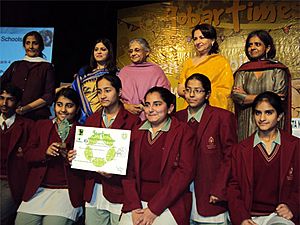Gobar Times facts for kids

First Issue, May, 1998
|
|
| Categories | Children's Environment Magazine |
|---|---|
| Frequency | Monthly |
| First issue | May 1998 |
| Company | Centre for Science and Environment |
| Country | India |
| Based in | New Delhi |
| Language | English |
| Website | Gobar Times - Official Website Centre for Science and Environment- Official Website |
Gobar Times is a monthly magazine all about the environment, made especially for young people like you! It's published by the Centre for Science and Environment (CSE), which is a group in India focused on environmental issues. This magazine comes out every month as a special extra part of another magazine called Down to Earth.
The very first Gobar Times magazine came out in May 1998. Since then, it has become very popular, reaching many readers across India and even in other countries. The magazine has a special character, its icon, named Pandit Gobar Ganesh. He's a wise, older Indian man who helps readers explore important topics and ideas about the environment. He's like a super smart friend you can ask anything about our planet! The current editor of the magazine is Sorit Gupto.
The word "Gobar" comes from Hindi and Nepali languages, and it means "cow dung." This name was chosen on purpose to show a special idea: that we can create useful things from what might seem like waste. It's all about being eco-friendly! For example, cow dung is used as a natural insecticide to protect plants. People also use it to plaster mud houses, making walls waterproof and floors cool. In many parts of rural India, gobar is a key source of energy. It's used as cooking fuel when people don't have access to other fuels like LPG. One of its biggest uses in India is in farming, where it works as natural fertilizer for crops. So, gobar is a really important part of rural life and a great symbol for technology that helps the environment.
Anil Agarwal, who started the Centre for Science and Environment, once said that 'Gobar' truly represents the spirit of India's environmental movement. He believed that the many ways gobar is used in Indian society perfectly show what good environmentalism is all about.
Discover the Green Schools Program
The Gobar Times magazine and the New Delhi-based Centre for Science and Environment (CSE) created an exciting project called the Green Schools Program. This program helps students check how environmentally friendly their own school is! They use a special guide called the "Green Schools Manual" to do this. It's like a fun survey where students look at their school's practices in key areas: water, air, land, energy, and waste.
- Water: Students learn how to save water and understand how to collect rainwater. They also explore ways to recycle used water at school.
- Air: Students investigate how people travel to school. This helps them see how different ways of transport affect air quality. They also think of new ideas to reduce pollution from vehicles.
- Land: Students identify different plants and animals living on the school campus. They also check if pesticides are used at school. This helps them understand how much the land can support.
- Energy: Students study how much electricity and other types of energy the school uses. They then look for ways to use less energy.
- Waste: Students find out how much and what kind of trash the school produces. They learn about composting and how to sort waste properly.
- Food: This section helps students think more about the types of food they eat and that are sold at school.
After checking all these areas, students get to give their school a "report card" on its environmental performance. They do this audit using the "Green Schools Program Manual" (2019 Edition). This manual gives them clear, step-by-step instructions on how to do their environmental check-up at school.
The main goal of the Green Schools Program is to help schools create a community of teachers, students, and parents who care about the environment. They want everyone to be active and skilled in protecting our planet. Schools can use the manual as part of their environmental studies classes or for fun activities in eco-clubs. The information students collect is put together and rated. This rating helps the school see how well it's doing environmentally. The aim is to understand what can be done to make the school even more sustainable and to make real improvements over time.
Green Schools Awards
The Gobar Times Green Schools Awards celebrate schools that are doing amazing things to manage natural resources on their own grounds. Schools send their "green reports" to CSE. These reports are carefully checked, and the best schools receive awards every year.
The top 10 schools in India that have made huge improvements in their environmental practices receive the 'Change Makers' award. Schools joining the program for the first time can compete in the 'New Schools' category. They are judged on how much students and teachers are involved, and how good their reports are. Also, schools that do exceptionally well in just one area, like water, energy, land, air, or waste, can apply for the special 'Best Managers' award.
Program Partners
The National Green Corps is a program run by the Ministry of Environment and Forest, which is part of the Indian government. State offices and CSE work together in many states across India. As the Green Schools network grows, these awards are now also held at the state level. The schools that are best at using resources efficiently at the state level are chosen by state agencies to compete for the national awards with CSE in Delhi.
Images for kids




